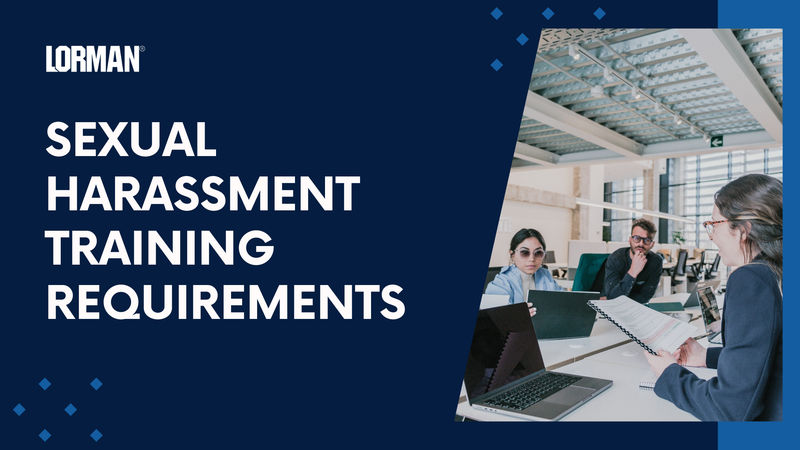
Sexual Harassment Training Requirements
Posted on 11/02/23 By Guest Contributor
More than one in five people in employment have experienced violence and harassment at work, including physical, psychological, or sexual. According to studies by the EEOC, workplace harassment often goes unreported. One study found that 90% of individuals who say they have experienced sexual harassment never take formal action against the harassment, such as filing a complaint.
In today's rapidly evolving work environment, ensuring a safe and inclusive workplace is of paramount importance. To help create such an environment, organizations must prioritize workplace sexual harassment training. By providing employees with the necessary knowledge and tools to recognize, prevent, and address harassment, companies can foster a culture of respect, dignity, and equality.
The EEOC strongly advises that all workplaces enroll employees in harassment prevention training to help identify, discourage, and eliminate harassment. In some states, sexual harassment training is required by law. These requirements may vary in terms of covered topics, frequency, and the size of the workplace.
Who Needs Sexual Harassment Training?
Every employee should receive sexual harassment training. This is the best way to ensure that all professionals know what behaviors are unacceptable and what to do if they experience or witness harassment in the workplace.
Training should be an ongoing and regular initiative rather than a one-time event. As societal norms and legal regulations change, it is crucial to keep employees informed about evolving policies, behaviors, and best practices. Generally, organizations are recommended to conduct harassment training sessions at least annually. However, certain factors may necessitate more frequent training, such as the introduction of new policies, the hiring of new employees, or any significant changes in the legal landscape.
The EEOC strongly recommends all employees receive training but, at the federal level, it is not required. However, several states (and cities) do mandate sexual harassment training. If you are located or do business in these states, training must be conducted to be within compliance. Currently, California, Connecticut, Delaware, Illinois, Maine, New York, Washington, Chicago, the District of Columbia, and New York City have statutes requiring sexual harassment training for certain employers.
How Often Do Employees Need to Complete Sexual Harassment Training?
Sexual harassment training is particularly important because it can occur at every level of business and is prominent across all industries. The frequency of sexual harassment training can ensure that all members of your team, including new hires and transfers, have been through the training recently and have the prevention information fresh in their minds.
For the states that require sexual harassment training, the interval varies from every year to every ten years.
Components of an Effective Sexual Harassment Training Program
An effective sexual harassment training program should cover general information on what harassment is, how it is identified, and what behaviors are considered unacceptable. Training should include your company's specific harassment policy, examples of scenarios, and specific guidance for managers and leaders, and end with a test for comprehension to ensure everyone understands.
For states with requirements, training components and recordkeeping rules may vary. It's important to check the legislation if you are within one of these states for specific training content requirements.
- Employers affected: Employers with five or more employees, including temporary or seasonal workers
- Employers must provide employees with supervisor duties at least two hours of sexual harassment training and all employees without supervisor duties at least one hour of training within six months of hire. After initial training, once every two years.
- Employers affected: Employers with three or more employees
- Employers must provide employees with education and two hours of training within six months of their start date. Periodic supplemental training must be provided not less than every ten years.
- Employers affected: Employers with 50 or more employees in Delaware
- Employers must provide training to employees within a year of their start date and every two years after that.
- Employers affected: Employers with 15 or more employees
- Employers must provide sexual harassment training at least once per year.
- Employers affected: Employers with 15 or more employees
- Employers must provide training to employees within one year of their start date. Additional training for supervisory and managerial employees.
- Employers affected: All employers
- Employers must provide employees with annual training.
- Employers affected: Employers in certain industries, like hotels, motels, retail corporations, security guard entities, and property service contractors
- Employers affected: All employers
- Employers must provide one hour of sexual harassment prevention for all employees (two hours for supervisors/managers) and one hour of bystander training for all employees, annually.
- Employers affected: Employers that have tipped employees
- Employers must provide training to all employees within 90 days of hire. Managers, owners, and operators must receive training at least once every two years.
- Employers affected: Employers with more than 15 employees
- Employers must provide training to employees within 90 days of hiring, annually after that.
Conclusion
Workplace sexual harassment training is an essential component of any organization's efforts to create a respectful and inclusive workplace. By conducting regular training sessions that are comprehensive, interactive, and inclusive of supervisors and managers, companies can empower their employees to recognize and prevent harassment in the workplace.
Lorman Education Services provides continuing education and compliance-focused courses and resources in several fields of work. Contact us to explore our resources for anti-harassment training and state training compliance.
This blog is intended for awareness only, it is not to be used for legal advice or counsel.
Related Articles
Humans are bound to make mistakes, and while it's essential to communicate words of affirmation, it's equally important to give constructive feedback to employees and peers.
Is an HR Certification Worth It? Discussing the Value of Continuing Education [Interview]
Vanessa Collins discusses how earning the PHR certification helped advance her career in human resources.
Neurodivergent workers often face numerous challenges, including difficulties with literal interpretations and reading non-verbal cues. To create an inclusive workplace that welcomes neurodiversity, organizations must prioritize effective communication an


![Is an HR Certification Worth It? Discussing the Value of Continuing Education [Interview] Is an HR Certification Worth It? Discussing the Value of Continuing Education [Interview]](https://image.lorman.com/article/blog/tr:w-368,h-207/106_is%20an%20HR%20Certification%20Worth%20It%20-%20value%20of%20continuing%20education.png)
.png)